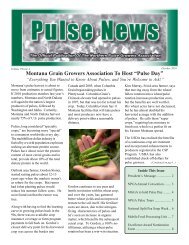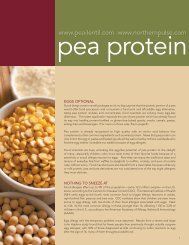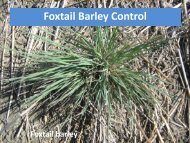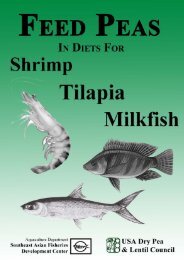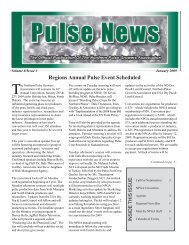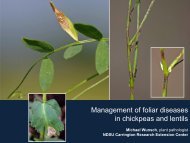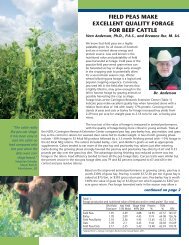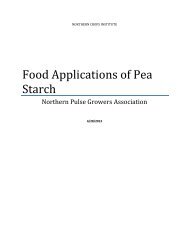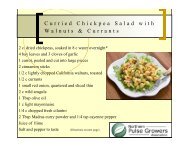Fractionation of pea flour - Northern Pulse Growers Association
Fractionation of pea flour - Northern Pulse Growers Association
Fractionation of pea flour - Northern Pulse Growers Association
Create successful ePaper yourself
Turn your PDF publications into a flip-book with our unique Google optimized e-Paper software.
C. Maaroufi et al. / Animal Feed Science and Technology 85 (2000) 61±78 65Assuming a cylindrical shape <strong>of</strong> all the pores existing on the external surface <strong>of</strong> theparticles, an average pore radius (r) is calculated:r ˆ 2 TPVSPSAAssuming a spherical shape <strong>of</strong> the particles, the surface area was also calculated(SPSA calc ) from the particle size distribution data (d 50 and S.D.) using the followingrelationship:SPSA calc: ˆ6…apparent density d 50 † exp …0:5…ln S:D:†2 †2.3. Chemical characterizationMoisture, crude protein (CP) and crude ®ber (CF) contents were determined accordingto <strong>of</strong>®cial methods (AFNOR, 1985). Starch (STA) was measured using the polarimetricprocedure (Ewers method). Water-insoluble cell wall (WICW) was determined accordingto AFNOR V18-111 (1989).2.4. Statistical analysesThe SAS package (SAS, 1995) was used for statistical calculations. A particle sizeeffect was studied by analysis <strong>of</strong> variance on the criteria measured in the laboratory(densities and SPSA). Regression analysis was performed to study the relationshipbetween couples <strong>of</strong> data, and principal component analysis (PCA) has been usedfor a more general interpretation in a multi-dimensional space (between-classescorrelations).3. Results3.1. Quality <strong>of</strong> the fractionation processThe sharpness <strong>of</strong> cut (Table 1) varied from 1.10 to 1.18. It was higher for the F0.5 andF1.52 fractions and traduced its lower level <strong>of</strong> `granulometric purity'. Concurrently, thevalues <strong>of</strong> cut size ap<strong>pea</strong>red generally distant from the size <strong>of</strong> the sieve openings, on whichthe fractionation was done. A pollution <strong>of</strong> the coarser fraction by the ®ner particles fromthe below fraction could explain this result.3.2. Physical characteristics3.2.1. GranulometryThe whole <strong>pea</strong> ¯our presented a median particle diameter <strong>of</strong> 0.669 mm and alogarithmic standard deviation (S.D.) <strong>of</strong> 1.99. The median particle diameter d 50 variedlargely among fractions (Table 1). However, some <strong>of</strong> them (F1.94 to F0.76) presented
66 C. Maaroufi et al. / Animal Feed Science and Technology 85 (2000) 61±78Table 2Physical characteristics <strong>of</strong> the different <strong>pea</strong> fractions and <strong>of</strong> hulls and kernels arising from dehulling (and ®negrinding: 0.5 mm screen) <strong>of</strong> <strong>pea</strong> shedsSubstrate aMeasuredSPSA b(m 2 g 1 )CalculatedSPSA(m 2 g 1 )RatioSPSAcalc./SPSAmeas.Total porousvolume(m 2 g 1 )Calculated Apparentmean radius density<strong>of</strong> the pores (g cm 3 )(nm)Bulkdensity(g dm 3 )Mediandiameterd 50 c (S.D.)(mm)Whole meal 0.118 0.008 0.06 0.4 6.8 1.432 715F2.5 0.102 0.003 0.03 0.1 2.0 1.434 607F1.94 0.132 0.003 0.02 0.2 3.0 1.455 540F1.52 0.125 0.004 0.03 0.4 6.4 1.427 553F1.04 0.125 0.006 0.04 0.4 6.4 1.441 604F0.76 0.137 0.009 0.07 0.3 4.4 1.448 666F0.5 0.140 0.013 0.09 0.3 4.3 1.438 656F0.23 0.167 0.013 0.08 0.5 6.0 1.455 642F0.122 0.209 0.035 0.17 0.5 4.8 1.436 576Throughs 0.418 0.234 0.56 0.8 3.8 1.465 530Pea hulls 0.533 0.043 0.08 3.2 12.0 1.500 nd d 0.616 (1.67)Pea kernels 0.409 0.384 0.94 1.1 5.4 1.430 nd 0.042 (5.02)a Each fraction is identi®ed by the size <strong>of</strong> the sieves that retains each <strong>of</strong> it: F2.5 is the fraction whose particlesare retained on the 2.5 mm sieve.b Speci®c surface area.c Measured with laser light diffraction.d Not determined.values out <strong>of</strong> the interval delimited by the size aperture <strong>of</strong> the sieves used to prepare thefractions (e.g. d 50ˆ0.934 mm for the fraction 1.52±1.04 mm). The logarithmic standarddeviation indicated narrow distributions around the d 50 (1.13±1.30), except for thethroughs (3.16). The hulls and the kernels fractions came from a ®ner grinding than the<strong>pea</strong> granulometric fractions (0.5 mm versus 4 mm screen). In comparison with the kernelsparticles, the hulls particles were coarser and less variable around their mean size(Table 2). The particle size distribution (Fig. 1) <strong>of</strong> the kernels showed a bimodaldistribution, whose ®rst <strong>pea</strong>k could mainly be identi®ed as starch granules (size <strong>of</strong> ca. 40 mm).It should be noted that the hulls and kernels analysis can improve the interpretation <strong>of</strong>the results for the different granulometric fractions. However, a direct comparisonbetween these fractions is not valid as they were derived from two levels <strong>of</strong> grinding.3.2.2. Apparent density and bulk densityThe apparent density (DENap.) <strong>of</strong> the whole <strong>pea</strong> ¯our was <strong>of</strong> 1.432 g cm 3 (Table 2). Itranged for the granulometric fractions from 1.427 to 1.465 g cm 3 . The bulk density(DENbu.) <strong>of</strong> the fractions ranged from 530 to 666 g dm 3 (Table 2). The whole ¯ourpresented a higher value (715 g dm 3 ), that can be explained by its high heterogeneity <strong>of</strong>particle size and form, leading to a probable decrease <strong>of</strong> the interparticle voids.Signi®cant differences (p
C. Maaroufi et al. / Animal Feed Science and Technology 85 (2000) 61±78 67Fig. 1. Pea particle size distribution <strong>of</strong> hulls, kernels and whole ¯our ground on a 0.5 mm aperture grindingscreen.3.2.3. Surface area and total porous volumeThe measured surface area values varied from 0.102 to 0.418 m 2 g 1 (Table 2). Theyincreased as the particle size decreased, with a stronger effect for the two ®ner fractionsF0.23 and F0.122 and particularly for the throughs (p
68 C. Maaroufi et al. / Animal Feed Science and Technology 85 (2000) 61±78Table 3Chemical analysis (% DM) <strong>of</strong> the different <strong>pea</strong> fractions and <strong>of</strong> the hulls and kernels <strong>of</strong> <strong>pea</strong> seeds a,bSubstrate Crude protein Crude fiber Starch Cell walls Ash MoistureWhole ¯our 23.7 5.5 52.7 13.2 3.28 13.9F2.5 22.1 9.1 51.2 13.8 2.91 13.5F1.94 21.8 9.4 49.4 15.5 2.76 13.6F1.52 22.4 9.5 49.8 22.4 3.19 13.7F1.04 21.9 11.8 47.9 20.4 3.04 13.7F0.76 24.2 4.6 53.5 12.1 2.99 13.5F0.5 25.2 3.7 55.2 12.1 3.21 13.4F0.23 25.5 2.7 55.1 10.2 3.15 13.6F0.122 25.7 1.7 55.4 8.7 3.38 13.3Throughs 22.5 0.9 62.2 5.9 2.98 13.2Pea hulls 3.3 56.2 4.7 90.6 nd b 10.1Pea kernels 23.9 2.9 55.8 8.1 nd 11.6a Each fraction is identi®ed by the size <strong>of</strong> the sieves that retains each <strong>of</strong> it: F2.5 is the fraction whose particlesare retained on the 2.5 mm sieve.b Not determined.22.4% DM). This evolution was not regular. In particular, the cell wall content wentthrough maximal values for the F1.52 and F1.04 fractions, whereas the cellularconstituents contents were minimal. Moreover, a step in the contents evolution ap<strong>pea</strong>redfor the ®ner fractions under F1.04, with a marked drop <strong>of</strong> cell wall content and anincrease <strong>of</strong> the cellular constituents contents. The throughs contained much more starchand less CP than the fraction immediately above (F0.122). Logically, starch and CP wereconcentrated in kernels, and structural carbohydrates in hulls.3.4. Cumulative proportions <strong>of</strong> the different characteristics according to the size <strong>of</strong>particlesThe cumulated percentages on each size class for the various characteristics arepresented in Figs. 2 and 3. The curves had nearly the same shape and their slopes differedmore or less from each other. This can re¯ect the differential separation <strong>of</strong> the variousparameters (more or less important quantities for a given size <strong>of</strong> particle). For the fractionF0.23 (d 50 <strong>of</strong> ca. 335 mm), the cumulated proportion <strong>of</strong> dry matter retained on this sievewas ca. 31%. At this size <strong>of</strong> particle, 40±50% <strong>of</strong> the surface area was located in the ®nepart <strong>of</strong> the feed, but only ca. 30% <strong>of</strong> the density (Fig. 2). For the chemical parameters(Fig. 3), the cytoplasmic constituents are separated more rapidly (higher slopes) than theparietal ones (respectively, ca. 30% and
C. Maaroufi et al. / Animal Feed Science and Technology 85 (2000) 61±78 69Fig. 2. Physical parameters (cumulated% Ð DENbu, bulk density; DENap, apparent density; SPSA, speci®csurface area; SPSAra, SPSA calculated/SPSA measured; TPV, total porous volume; DM, dry matter).alone (|r|>0.7) (Table 4). When the throughs was removed from the analysis, allcorrelations became significant (Table 5). WICW and CF (hulls) were opposed to STAand CP (kernels). The link with moisture could be explained by a preferential adsorption<strong>of</strong> water by cell walls (r moisture/WICWˆ0.7). This phenomenon was underlined byFig. 3. Chemical composition (cumulated% Ð CP, crude protein; WICW, water-insoluble cell walls; DM, drymatter).
Table 4Correlations between physical and chemical characteristics aSubstrateCudeproteinCrudefiberStarchCellwallsRawashMoistureBulkdensityApparentdensitySPSA b SPSAra. c TPV d MediandiameterCrude protein 1.00Crude ®ber 0.74 1.00Starch 0.43 0.91 1.00Cell walls 0.53 0.90 0.88 1.00Raw ash 0.70 0.43 0.21 0.12 1.00Moisture 0.26 0.61 0.72 0.68 0.06 1.00Bulk density 0.47 0.13 0.08 0.07 0.38 0.46 1.00Apparent density 0.04 0.40 0.53 0.55 0.53 0.46 0.32 1.00SPSA 0.02 0.64 0.86 0.66 0.02 0.70 0.48 0.66 1.00SPSAra. 0.01 0.64 0.87 0.67 0.01 0.69 0.40 0.60 0.99 1.00TPV 0.20 0.62 0.73 0.47 0.34 0.38 0.26 0.46 0.86 0.83 1.00Median diameter 0.64 0.75 0.65 0.51 0.59 0.31 0.17 0.31 0.55 0.53 0.79 1.00a Correlation coef®cients/prob.>|R| under H0:rˆ0/Nˆ10. The numbers in italics represent the signi®cant correlations at the level <strong>of</strong> 5% (|R|: 0.63).b Measured surface area.c Measured surface area/calculated surface area.d Total porous volume.70 C. Maaroufi et al. / Animal Feed Science and Technology 85 (2000) 61±78
Table 5Correlations between physical and chemical characteristics (without throughs) aCrudeproteinCrudefiberStarchCellwallsRawashMoistureBulkdensityApparentdensitySPSA b SPSAra. c TPV d MediandiameterCrude protein 1.00Crude ®ber 0.97 1.00Starch 0.96 0.98 1.00Cell walls 0.79 0.87 0.87 1.00Raw ash 0.68 0.60 0.58 0.27 1.00Moisture 0.49 0.48 0.53 0.54 0.07 1.00Bulk density 0.43 0.43 0.47 0.42 0.33 0.27 1.00Apparent density 0.13 0.16 0.10 0.34 0.52 0.14 0.05 1.00SPSA 0.76 0.72 0.63 0.59 0.54 0.58 0.16 0.23 1.00SPSAra. 0.86 0.83 0.79 0.71 0.72 0.62 0.15 0.06 0.89 1.00TPV 0.58 0.47 0.36 0.13 0.77 0.10 0.14 0.03 0.67 0.58 1.00Median diameter 0.80 0.70 0.62 0.41 0.73 0.13 0.41 0.11 0.69 0.73 0.85 1.00a Correlation coef®cients/prob.>|R| under H0:rˆ0/Nˆ10. The numbers in italics represent the signi®cant correlations at the level <strong>of</strong> 5% (|R|: 0.67).b Measured surface area.c Measured surface area/calculated surface area.d Total porous volume.C. Maaroufi et al. / Animal Feed Science and Technology 85 (2000) 61±78 71
72 C. Maaroufi et al. / Animal Feed Science and Technology 85 (2000) 61±78Hooper and Welch (1985), assessing the influence <strong>of</strong> the fibrous structure <strong>of</strong> legumeforages in the water molecules trap.3.5.1.2. Correlation between physical criteria. There were less significant correlationsbetween the physical parameters (Table 4). The SPSA or the ratio SPSAcalc./SPSA(SPSAra.) were positively linked to the TPV (r>0.8) and the SPSA to the apparentdensity (DENap.) (rˆ0.7). The mean particle size (d 50 ) was linked significantly with theTPV alone (rˆ0.8).The throughs almost always presented an extreme position in the relationship betweenvariables. This is due to high values <strong>of</strong> SPSA, SPSAra., TPV and a very low value <strong>of</strong> d 50 .With the withdrawal <strong>of</strong> this fraction from the analysis (Table 5), the density values werenot correlated to other variates, but the `morphologic' criteria (SPSA, SPSAra., TPV andd 50 ) were signi®cantly and mutually correlated. As we could expect, the SPSA <strong>of</strong> themuch lower d 50 fractions was higher. The fact that TPV also ap<strong>pea</strong>red higher for the smallparticles could be explained by more surface cracks for these fractions.Finally, moisture was linked negatively to the SPSA criteria, although the measurementwas done on dry samples after the out gassing (Table 4). This could be due to a laboratoryartefact: the measured surface (SPSA) could be directly linked to the water withdrawal,because <strong>of</strong> an effect <strong>of</strong> exposed surface to exchanges with the air while grinding orfractionating. With the smallest particles (high SPSA), these processes would lead to areduction <strong>of</strong> the interstitial spaces that are responsible for the water holding capacity(Robertson and Eastwood, 1981).3.5.1.3. Correlation between physical and chemical criteria. We notice a generalevolution <strong>of</strong> the chemical composition (CP, STA, CF, WICW) according to the geometry<strong>of</strong> the particles (d 50 , SPSA, SPSAra.) (r>0.6, Table 4), except that the d 50 was notcorrelated to the WICW and the surface parameters were not correlated to the CP. But, byremoving the throughs from the data, the surface parameters and the CP becamepositively correlated (r>0.6, Table 5).3.5.2. Principal component analysisThe two ®rst components (10 variables and 10 observations) accounted for 81% <strong>of</strong> thetotal variance (Fig. 4). The ®rst axis was mainly linked on one hand, to the ®bre contents<strong>of</strong> the particles, to their median diameter and to a lesser extent to the moisture content,and on the other hand, to the starch content and the SPSA parameters. The second axiswas more associated with a protein enrichment. The apparent density is not wellrepresentedon the correlation circle.The projection <strong>of</strong> the granulometric fractions on the components (Fig. 4) indicates aclustering <strong>of</strong> the samples into three groups:1. a group <strong>of</strong> coarse fractions (F2.5, F1.94, F1.52, F1.04), that contain more cell wallsand less starch, that have a higher moisture level, an intermediary or even low valuefor F1.94 <strong>of</strong> bulk density and a low value <strong>of</strong> SPSA;2. a group <strong>of</strong> intermediate to ®ne size fractions, enriched with CP and starch, poorer withcell walls, and higher in bulk density;
Fig. 4. Correlation circle for the chemical and physical characteristics <strong>of</strong> the <strong>pea</strong> fractions (CP, crude protein; CF, crude ®ber; WICW, water-insoluble cell walls;DENbu, bulk density; DENap, apparent density; SPSA, speci®c surface area; SPSAra, SPSA calculated/SPSA measured; d 50 , median diameter) and projection <strong>of</strong> the <strong>pea</strong>fractions on the components.C. Maaroufi et al. / Animal Feed Science and Technology 85 (2000) 61±78 73
74 C. Maaroufi et al. / Animal Feed Science and Technology 85 (2000) 61±783. a group with the throughs alone, higher in SPSA and SPSAra., higher in starchcontent, but lower in CP content according to the F0.122 fraction, and with a low value<strong>of</strong> bulk density, close to that <strong>of</strong> F1.94.On the individuals projection, the whole ¯our had a special position. This is due to itshigh bulk density value, that can be explained by its high heterogeneity in particle size(see Section 3.2.2).4. DiscussionThe applied fractionation process produced nine particle size classes welldifferentiatedfrom each other with narrow particle size distributions (except for thethroughs), but well spread over a large granulometric range (size <strong>of</strong> particles between
C. Maaroufi et al. / Animal Feed Science and Technology 85 (2000) 61±78 75linked to the mass (DENap. and DENbu). The evolution <strong>of</strong> these two groups differsbetween fractions. The `morphology' parameters increased rapidly in the ®ne particles,that contained therefore a higher percentage <strong>of</strong> the total surface area and TPV<strong>of</strong> the ¯our,while density values evolved in a more irregular manner. Some physical characteristicscould be considered as composition tracers: a high speci®c surface area is for example anindicator <strong>of</strong> particles enriched with cytoplasmic constituents. These criteria could bepotentially used as a way to better de®ne the characteristics <strong>of</strong> feedstuffs.In contrast to our density results, several authors showed that as feed particle sizedecreases, density increases (Hooper and Welch, 1985; Martz and Belyea, 1986;Siciliano-Jones and Murphy, 1991). The experiments usually involved soaking theparticles in solutions <strong>of</strong> different gravity gradients. The results may differ owing to thehydration capacity <strong>of</strong> the particles. It is interesting to note that on dry feeding, theapparent density <strong>of</strong> fractions did not change systematically with particle size. With thesame method, De Boever et al. (1993) achieved a similar result with maize silage. So, thetreatment `grinding±fractionation' does not lead to ®nes <strong>of</strong> greater density. That wasshown as well by the non-signi®cant correlation between density and chemicalcomposition. So this criterion did not permit a speci®c characterization <strong>of</strong> the differentgranulometric fractions.In the same way, it is doubtful that TPV could be regarded as a signi®cant parameter inthe characterization <strong>of</strong> fractions. Even if it ap<strong>pea</strong>red highly correlated to the mediandiameter (rˆ0.8), the need to assimilate all the external cracks on the particles tocylindric pores for its determination, the low values recorded and the high variationbetween the measures, reduce the interest <strong>of</strong> TPV in feed characterization. Chesson et al.(1997) reported higher TPV values <strong>of</strong> ca. 2.7 mm 3 g 1 for wheat ground through 1 mmscreen size. These data are more similar to the more ®nely ground hulls and kernels (3.2and 1.1 mm 3 g 1 , respectively) than to the granulometric fractions (0.5 mm grindingscreen versus 4 mm grinding screen), which suggests that TPV is linked to the ®neness <strong>of</strong>grinding. However, even if the hulls and kernels fractions were obtained after a ®nergrinding than the wheat ¯our, their TPV were <strong>of</strong> the same order as the wheat value; so wecan deduce that the <strong>pea</strong> ¯our would be less porous. The calculated mean radius <strong>of</strong> thepores was from 2 to 6 nm for the different fractions indicating that <strong>pea</strong> fractions arecomposed principally <strong>of</strong> meso-pores (de®ned as being from 2 to 30 nm).In a more global approach, the different physical and chemical characteristics <strong>of</strong>the granulometric fractions seemed to re¯ect the fact that hulls and kernels followdifferent comminution laws. So, two populations <strong>of</strong> particles were coexisting: apopulation <strong>of</strong> hull particles accumulated in the coarser fractions (F1.94 to F1.04), and apopulation <strong>of</strong> kernels, probably bi-modal and more represented in the medium and ®nefractions.Effectively, the ®rst element suggesting the differential grinding behaviour <strong>of</strong> hulls andkernels was their different particle size distribution, in spite <strong>of</strong> being ground on the samescreen. The higher elasticity <strong>of</strong> hulls made them more resistant to the crushing action <strong>of</strong>the grinder, certainly because <strong>of</strong> their high content <strong>of</strong> structural carbohydrates (Brennanet al., 1981). This resistance would explain why the hull particles <strong>of</strong> the <strong>pea</strong> were coarserthan kernel ones. The `grinding±fractionation' process has led to a physical separation <strong>of</strong>the constituents <strong>of</strong> the <strong>pea</strong> seed in three groups <strong>of</strong> fractions: a group <strong>of</strong> coarse fractions
76 C. Maaroufi et al. / Animal Feed Science and Technology 85 (2000) 61±78where hulls were accumulated, a group <strong>of</strong> ®ner fractions enriched with kernels and thethroughs mainly composed by starch granules.5. ImplicationsNine granulometric fractions were produced with a good classi®cation accuracy. Theywere characterized chemically and physically. The observed results or existingrelationships ap<strong>pea</strong>red complex as was also the grinding process that led, afterfractionation <strong>of</strong> a <strong>pea</strong> ¯our, to granulometric fractions <strong>of</strong> variable physical and chemicalcharacteristics. According to the constituents <strong>of</strong> the seed, there were differentcomminution laws, that could explain these results. The application <strong>of</strong> different particlecharacterization methods (linked to shape or mass <strong>of</strong> the particles), other than simplesieving ap<strong>pea</strong>red interesting to de®ne more speci®cally and completely the feed particles.It is necessary indeed, to take into account different points in order to compare withother research studies:The type <strong>of</strong> apparatus (e.g. granulometry by mechanical sieving and granulometry bylaser diffraction) can give different results as Siciliano-Jones and Murphy (1991)showed by observing the evolution <strong>of</strong> two types <strong>of</strong> density called true and functionalspecific gravity, when altering the size particles or studying the in vitro fermentation <strong>of</strong>different feedstuffs.The criteria <strong>of</strong> particles qualification, as the definition <strong>of</strong> their size (e.g. mean particlesize or specific surface area); besides Michalet-Doreau and Cerneau (1991) advised theuse <strong>of</strong> criteria like mean particle size which are more precise than one like the size <strong>of</strong>the grinding screen.The intrinsic qualities <strong>of</strong> the substrate (moisture, chemical composition, mechanicalproperties <strong>of</strong> the cells...) (Brennan et al., 1981).The technological process <strong>of</strong> preparation (type <strong>of</strong> grinder...), as Richards et al. (1995)underlined when obtaining differences in the in vitro degradation <strong>of</strong> the cereals starch,with the use <strong>of</strong> different grinding principles or different grinding parameters.In a second paper, we will try to set up an original work based on the association <strong>of</strong>technology and characterization developed in the present part and nutritional studies inorder to assess the ability <strong>of</strong> physical characterization to explain and predict the nutritivevalue <strong>of</strong> <strong>pea</strong>s.AcknowledgementsThe authors thank the representatives <strong>of</strong> the GIE Euretec II (ARRIVE, CCPA,CETIOM, GUYOMARC'H, ITCF, ONIDOL, SANDERS, SOFIPROTEOL, UCANOR,UNICOPA, UNIP) for advice and support <strong>of</strong> this work within the Eureka projectEuroproteins EU-623. We gratefully acknowledge Pr Sauvant, Dr. Giger-Reverdin andDr. Chapoutot for advice and E. Drouet and G. Lorand for technical collaboration. Wethank the IDAC laboratories (Institut Departmental d'Analyse et de Conseil Ð PO Box
C. Maaroufi et al. / Animal Feed Science and Technology 85 (2000) 61±78 7780603, 44306 Nantes cedex 3, France) for the chemical analysis, and the laboratory <strong>of</strong>chemistry <strong>of</strong> the Sanders Aliments Company (PO Box 32, 91201 Athis-Mons cedex,France) for the determination <strong>of</strong> the Water-Insoluble Cell Walls.ReferencesAFNOR NF X11-501, decembre 1970. Toiles meÂtalliques et toÃles perforeÂes dans les tamis de controÃle.Dimensions nominales des ouvertures. Paris-La-DeÂfense, 4 pp.AFNOR Standard X11-666, septembre 1984. Analyse granulomeÂtrique des poudres. MeÂthode par diffraction.Paris-La-DeÂfense, 11 pp.AFNOR NF X11-635, juillet 1985. RepreÂsentation des distributions granulomeÂtriques. Partie 1: ModeÁles deReÂfeÂrence. Paris-La-DeÂfense, 19 pp.AFNOR NF X11-636, juillet 1985. RepreÂsentation des distributions granulomeÂtriques. Partie 2: Ajustementd'une courbe cumulative expeÂrimentale aÁ un modeÁle de reÂfeÂrence. Cas du tamisage. Paris-La-DeÂfense, 24 pp.AFNOR, 1985. Aliments des Animaux. MeÂthodes d'analyse franc,aise et communautaires. Paris-la DeÂfense,France.AFNOR V18-111, fevrier 1989. Aliments des animaux. DeÂtermination de la teneur en parois veÂgeÂtalesinsolubles dans l'eau. Paris-La-DeÂfense, 8 pp.AFNOR NF X11-620, decembre 1994. DeÂtermination de la surface speÂci®que des solides par adsorption de gazaÁ l'aide de la meÂthode BET. Paris-La-DeÂfense, 16 pp.Bertrand, D., Guibert, D., Melcion, J-P., 1998. Evolution <strong>of</strong> the chemical composition <strong>of</strong> <strong>pea</strong> seeds according toparticle size during comminution using a markovian process. 9th Euro<strong>pea</strong>n symp. on comminution, 8±10September, Albi (France), pp. 175±183.Bjorndal, K.N., Bolten, A.B., Moore, J.E., 1990. Digestive fermentation in herbivores: effect <strong>of</strong> food particlesize. Physiol. Zool. 63 (4), 710±721.Brennan, J.G., Butters, J.R., Cowell, N.D., Lilly, A.E.V., 1981. Size reduction and screening <strong>of</strong> solids in foodengineering operations. Appl. Sci. Publ., London (UK), pp. 61±84.Chesson, A., Gardner, P.T., Wood, T.J., 1997. Cell wall porosity and available surface area <strong>of</strong> wheat straw andwheat grain fractions. J. Sci. Food Agric. 75, 289±295.De Boever, J.L., De Brabander, D.L., De Smet, A.M., Vanacker, J.M., Boucque, C.V., 1993. Evaluation <strong>of</strong>physical structure. 2. Maize silage. J. Dairy Sci. 76, 1624±1634.Emanuele, S.M., Staples, C.R., 1988. Effect <strong>of</strong> forage particle size on in situ digestion kinetics. J. Dairy Sci. 71,1947±1954.Friedrich, W., Hansen, H.D., 1980. Kreislauf-Vermahlung und Fraktionierung. Teil 2. Aufbereitungs-Technik 21(10), 515±520.Galyean, M.L., Wagner, D.G., Owens, F.N., 1981. Dry matter and starch disap<strong>pea</strong>rance <strong>of</strong> corn and sorghum asin¯uenced by particle size and processing. J. Dairy Sci. 64, 1804±1812.Hansen, R.C., Stewart, R.E., 1965. Energy-size reduction relations in agricultural grain comminution. Trans.A.S.A.E. 8 (2), 230±234, 237.Hansen, R.C., Henderson, S.M., 1966. Agricultural grain comminution: sizing critique and nutritive analysis.Trans. A.S.A.E. 9, 818±823.Hooper, A.P., Welch, J.G., 1985. Effects <strong>of</strong> particle size and forage composition on functional speci®c gravity. J.Dairy Sci. 68 (5), 1181±1188.Hunt, C.W., 1996. Factors affecting the feeding quality <strong>of</strong> barley for ruminants. Anim. Feed Sci. Technol. 62,37±48.Lykos, T., Varga, G.A., 1995. Effects <strong>of</strong> processing method on degradation characteristics <strong>of</strong> protein andcarbohydrate sources in situ. J. Dairy Sci. 78, 1789±1801.Martz, F.A., Belyea, R.L., 1986. Symposium: forage utilization by the lactating cow. Role <strong>of</strong> particle size andforage quality in digestion and passage by cattle and sheep. J. Dairy Sci. 69, 1996±2008.Michalet-Doreau, B., Cerneau, P., 1991. In¯uence <strong>of</strong> foodstuff particle size on in situ degradation <strong>of</strong> nitrogen inthe rumen. Anim. Feed Sci. Technol. 35, 69±81.
78 C. Maaroufi et al. / Animal Feed Science and Technology 85 (2000) 61±78Prasher, C.L., 1986. Crushing and grinding process handbook. Wiley, Chichester, GB, 474 pp.Richards, C.J., Pederson, J.F., Britton, R.A., Stock, R.A., Krehbiel, C.R., 1995. In vitro starch disap<strong>pea</strong>ranceprocedure modi®cations. Anim. Feed Sci. Technol. 55, 35±45.Robertson, J.A., Eastwood, M.A., 1981. A method to measure the water holding properties <strong>of</strong> dietary ®bre usingsuction pressure. Br. J. Nutr. 48, 247±255.Rouquerol, J., Fairbridge, C.W., Everett, D.H., Haynes, J.H., Pernicone, N., Ramsay, J.D.F., Sing, K.S.W.,Unger, K.K., 1994. Recommendations for the characterization <strong>of</strong> porous solids. Pure Appl. Chem. 66 (8),1739±1758.SAS, 1995. SAS/STAT User's Guide, version 5, SAS Inst. Inc., Cary, NC, USA.Siciliano-Jones, J., Murphy, M.R., 1991. Speci®c gravity <strong>of</strong> various feedstuffs as affected by particle size and invitro fermentation. J. Dairy Sci. 74, 896±901.Smigerski, H.-J., 1984. Electrostatic charging and screening behaviour <strong>of</strong> ®ne-grained bulk materials.Aufbereitungs-Technik. 25 (7), 373±379.Sosulski, F.W., 1983. Legume protein concentration by air classi®cation. In: Development in food proteins, Vol.2, BJF. Hudson ed, Appl. Sci. publ., London (UK), pp. 173±213.Tromp, K.F., 1937. Neue Wege fuÃr die Beurteilung des Aufbereitungs von Steinkohlen. GluÈcklauf 11, 125±131,151±156.Wadhwa, M., Dharam, P., Kataria, P., Bakshi, M.P.S., 1998. Effect <strong>of</strong> particle size <strong>of</strong> corn grains on the release <strong>of</strong>nutrients and in sacco degradability. Anim. Feed Sci. Technol. 72, 11±17.Wright, D.J., Bumstead, M.R., Coxon, D.T., Ellis, H.S., Dupont, S., Chan, H.W.S., 1984. Air classi®cation <strong>of</strong><strong>pea</strong> ¯our Ð Analytical studies. J. Sci. Food Agric. 35, 531±542.



